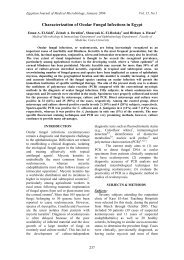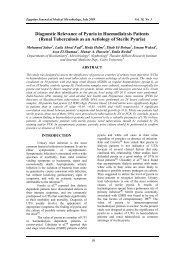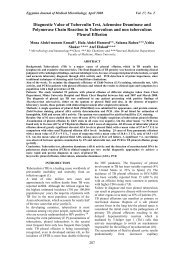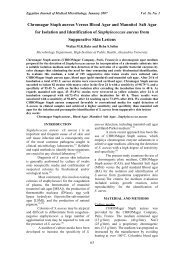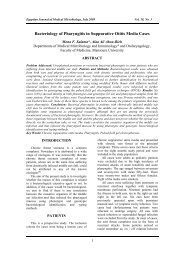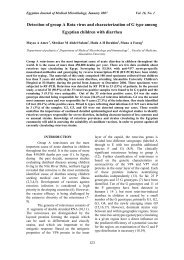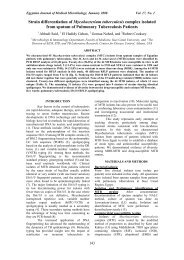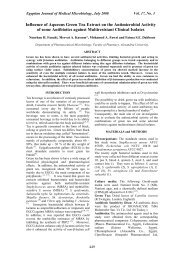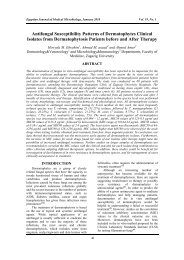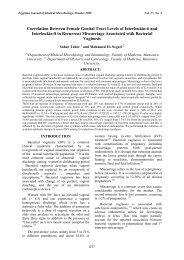Evaluation of the Antimicrobial and Cytotoxic Activity of Epiphany ...
Evaluation of the Antimicrobial and Cytotoxic Activity of Epiphany ...
Evaluation of the Antimicrobial and Cytotoxic Activity of Epiphany ...
You also want an ePaper? Increase the reach of your titles
YUMPU automatically turns print PDFs into web optimized ePapers that Google loves.
Egyptian Journal <strong>of</strong> Medical Microbiology, January 2007 Vol. 16, No. 1<br />
The <strong>Epiphany</strong> obturating system<br />
(Pentron Clinical Technologies, Wallingford,<br />
CT) which is a dual curable dental resin<br />
composite sealer uses Resilon points <strong>and</strong> is<br />
bonded to <strong>the</strong> root dentin 12 . Resilon (Resilon<br />
Research LLC, Madison, CT), a <strong>the</strong>rmoplastic<br />
syn<strong>the</strong>tic polymer based root canal filling<br />
material, has been developed that performs<br />
like gutta-percha, has <strong>the</strong> same h<strong>and</strong>ling<br />
properties, <strong>and</strong> for retreatment purposes may<br />
be s<strong>of</strong>tened with heat or dissolved with<br />
solvents like chlor<strong>of</strong>orm. Based on polymers<br />
<strong>of</strong> polyester, Resilon contains bioactive glass,<br />
bismuth oxychloride <strong>and</strong> barium sulfate 12 .<br />
Resilon associated with <strong>Epiphany</strong> has<br />
recently been introduced. Some <strong>of</strong> its<br />
mechanical <strong>and</strong> chemical properties have<br />
been evaluated with controversial results 11, 13 .<br />
In contrast, <strong>the</strong> biological properties <strong>of</strong><br />
Resilon <strong>and</strong> <strong>Epiphany</strong> are not well<br />
documented 14 .<br />
The properties <strong>of</strong> root canal<br />
cements can be divided into physicochemical,<br />
antimicrobial <strong>and</strong> biological 15 . Therefore, <strong>the</strong><br />
aim <strong>of</strong> this study was to in vitro evaluate <strong>the</strong><br />
antimicrobial <strong>and</strong> cytotoxic properties <strong>of</strong><br />
<strong>Epiphany</strong> sealer in comparison with <strong>the</strong><br />
commonly used root canal sealers.<br />
MATERIALS AND METHODS<br />
The various root canal sealers that<br />
were tested in <strong>the</strong> present study are <strong>the</strong><br />
adhesive resin root canal sealer (<strong>Epiphany</strong>)†,<br />
ZOE based sealer (EndoFill)‡, calcium<br />
hydroxide based sealer (Apexit)*, glass<br />
ionomer based sealer (Ketac-Endo)§ <strong>and</strong><br />
Resin sealer (AH-26) ‡.<br />
†Pentron clinical technologies<br />
‡DentSply<br />
*Ivoclar Vivadent<br />
§3M ESPE<br />
<strong>Antimicrobial</strong> test<br />
Agar-well diffusion method (AWDM):<br />
Cultures <strong>of</strong> E. faecalis , S. aureus,<br />
E.coli <strong>and</strong> C. albican were obtained from<br />
endodontic isolates. All microorganisms<br />
were previously subcultured in appropriate<br />
culture plates <strong>and</strong> under gaseous conditions<br />
to confirm <strong>the</strong>ir purity. From <strong>the</strong> broth<br />
culture suspensions <strong>of</strong> <strong>the</strong> tested<br />
microorganism 0.2 ml were prepared<br />
adjusted to No. 0.5 McFarl<strong>and</strong> scale were<br />
spread on four Petri dishes containing<br />
Mueller-Hinton Agar medium. Five wells <strong>of</strong><br />
5mm depth <strong>and</strong> 4mm diameter were<br />
punched in <strong>the</strong> agar plates <strong>and</strong> filled with <strong>the</strong><br />
test sealers (mixed according to<br />
manufacturer instructions). The plates were<br />
incubated aerobically at 37Cº for 48h. The<br />
diameters <strong>of</strong> <strong>the</strong> zones <strong>of</strong> microbial<br />
inhibition around each well were measured<br />
in millimeters after <strong>the</strong> incubation period.<br />
The inhibitory zone was considered to be <strong>the</strong><br />
shortest diameter from <strong>the</strong> outer margin <strong>of</strong><br />
<strong>the</strong> well to <strong>the</strong> initial point <strong>of</strong> <strong>the</strong> microbial<br />
growth.<br />
Three replicates were measured for<br />
each microorganism <strong>and</strong> a mean diameter was<br />
determined for each sealer. Greater diameters<br />
<strong>of</strong> zones <strong>of</strong> inhibition were interpreted to<br />
indicate greater antimicrobial activity <strong>of</strong> <strong>the</strong><br />
involved sealers 16, 17 .<br />
<strong>Cytotoxic</strong>ity assay<br />
Test materials <strong>and</strong> specimen preparation:<br />
The tested materials were mixed<br />
according to <strong>the</strong> manufacturer's instructions.<br />
Freshly mixed materials were filled in<br />
polyethylene rings <strong>of</strong> 5mm inside diameter<br />
<strong>and</strong> 4mm in height. The test was performed<br />
on fresh mix <strong>and</strong> 24h set mix. To prevent<br />
contamination <strong>of</strong> <strong>the</strong> set samples <strong>the</strong>y were<br />
exposed to UV light for 2h before performing<br />
<strong>the</strong> test. In a pilot study made previously 18 ,<br />
this period was sufficient to sterilize<br />
experimental materials.<br />
Cell Culture:<br />
Periodontal ligament cells (PDL)<br />
were obtained from teeth extracted for<br />
orthodontic purposes. Fibroblasts were grown<br />
in Dulbecco's modified Eagles medium<br />
(DMEM) supplemented with 10% fetal<br />
bovine serum <strong>and</strong> antibiotics (10,000 units <strong>of</strong><br />
penicillin-G/ml, 10 mg <strong>of</strong> streptomycin/ml<br />
<strong>and</strong> 20 mM <strong>of</strong> L-glutamine) 19 .<br />
Growth Measurement:<br />
The fibroblast cells were plated at a<br />
density <strong>of</strong> 3-4 x10 4 cells/ml <strong>and</strong> dispensed<br />
onto 96-well culture plate with 1ml <strong>of</strong><br />
medium per well <strong>and</strong> incubated at 37Cº<br />
supplemented with 5% CO 2 for 48h to allow<br />
96



